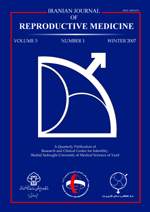
|
International Journal of Reproductive BioMedicine
Research and Clinical Center for Infertility, Shahid Sadoughi University of Medical Sciences of Yazd
ISSN: 1680-6433
EISSN: 1680-6433
Vol. 9, No. 4, 2011, pp. 315-318
|
 Bioline Code: rm11048
Bioline Code: rm11048
Full paper language: English
Document type: Short Communication
Document available free of charge
|
|
|
International Journal of Reproductive BioMedicine, Vol. 9, No. 4, 2011, pp. 315-318
| en |
Luteal phase estradiol versus luteal phase GnRH antagonist administration: their effects on antral follicular size coordination and basal hormonal levels
Rashidi, Batool; Nasiri, Roya; Rahmanpour, Haleh; Tehraninejad, Ensieh Shahrokh & Deldar, Maryam
Abstract
Background: The differential efficacy between long GnRH agonist with antagonist can partly be due to the preexisting differences in the early antral follicles before ovarian stimulation.
Objective: To compare the effect of pretreatment by estradiol with GnRH antagonist on antral follicular size coordination and basal hormone levels in GNRH antagonist protocol.
Materials and Methods: On cycle day 3 (control/day 3), women underwent measurements of early antral follicles by ultrasound and serum FSH and ovarian hormones then were randomized to receive oral estradiol 4mg/day (n=15) or 3mg cetrorelix acetate (n=15) in luteal phase before subsequent antagonist protocol. Participants were re-evaluated as on control/day 3.
Results: There was a significant reduction of mean follicular sizes in each group after medical intervention (7.63±2.11 Vs. 4.30±0.92 in group A and 8.73±1.96 Vs. 4.13±1.11 in group B) (p=0.0001). The magnitude of follicular size reduction was significantly higher in group B (-4.60±2.04 Vs. -3.33±2.28) (0.027). There was a non significant attenuation of follicular size discrepancies in two groups. FSH and inhibin B levels in the day 3 of the next cycle in both groups were significantly decreased but did not have significant difference between two groups.
Conclusion: Both luteal E2 and premenstrual GnRH antagonist administration reduces the follicular sizes significantly and GnRH antagonist acts more potently than E2 in this way but attenuation of follicular size discrepancies in both treatment is not significant.
Keywords
Follicular synchronization, Estradiol, GnRH antagonist
|
| |
© Copyright 2011 Iranian Journal of Reproductive Medicine.
Alternative site location: http://www.ijrm.ir
|
|
